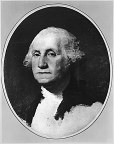|
|
 |
 |
|
Reading Guide |
| 6. |
Forging a National Identity: Six Patriotic Pieces
| - 1789 | "Ode to the President of the United States" |
| - 1796 | "Liberty. In the form of the Goddess of Youth" (print) |
| - 1798 | "Hail Columbia" (song) |
| - 1800 | "Sacred to the Memory of Washington" (engraving) |
| - 1812 | "The First Great Western Empire" (print) |
| - 1819 | "Song for the Anniversary of American Independence" |
|
|
 |
A nation's concept of itself evolves as surely as one's personal self-image. In the early years of the republic there appeared in abundance the songs, poems, prints, and other popular creations through which a national "iconography" would develop. Here are six patriotic pieces—three prints, two songs, and a poem—that span the three decades covered in this seminar. What is their purpose? How do they reflect the ideals and anxieties expressed by the "Founding Fathers" in this section? What evolving national identity do they reveal? Other than "Hail Columbia," these pieces are virtually unknown today, and they help us re-create the mindset of citizens in young America. Certainly classroom-friendly. 7 pages.
A few notes. (1) Often called the first national anthem, "Hail Columbia" was written in response to the Quasi-War between the U.S. and France in the late 1790s. (2) Hebe, pictured as Liberty in the 1796 print, was the Greek goddess of youth and served as the cup-bearer to the gods. (3) Notice the phrase at the top of the print "The First Great Western Empire."
Discussion questions
| · |
As a whole, how do these pieces define "living the revolution"? |
| · |
On what national strength can Americans rely? Which internal threat should they most fear? |
| · |
What mythic role does George Washington play in these pieces? Against what foe will he lead America? |
| · |
What message do the numerous religious allusions convey? |
| · |
How do the pieces reflect anxiety that the republic may not persevere? |
| · |
What aspects of these pieces are no longer found in our national iconography? |
| · |
What are the modern equivalents of these patriotic pieces?
|
» Link |
 |
 |
Topic Framing Questions
| • |
What core political issues defined themselves in the new republic? |
| • |
What caused the greatest optimism and anxiety among American leaders? |
| • |
What do the religious overtones in these political texts express? |
| • |
What national identity evolved in the three decades from 1789 to 1820?
|
|
|
 |
 |
|
 |
